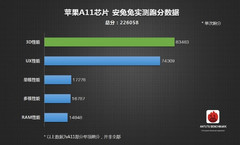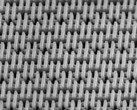Apple has promised big things from their new A11 Bionic SoC contained within the iPhone 8, iPhone 8 Plus, and iPhone X, claiming that it will provide a 30 percent CPU improvement, 25 percent GPU improvement, and 50 percent efficiency improvement over last year's A10 Fusion SoC. The A11 is Apple's first hexa-core SoC, utilizing two high-performance 'Monsoon' cores and four power-efficient 'Mistrel' cores, which can all work in tandem when presented with heavy workloads. This configuration compares to the A10's quad-core design that only allows two cores to run at once (either the two high-performance, or the two energy-efficient cores), and the A9's dual-core configuration.
A few days ago, we reported some leaked Geekbench results which showed the A11 getting 4061 single-core and 9959 multi-core scores, well above those achieved by any current Android devices, and slightly ahead of the A10X Fusion designed for the iPad.
Now there are the results of an Antutu benchmark online which apparently show the A11 with a combined score of 226,058, which is slightly over 45,000 points ahead of the closest Android competitor, the Snapdragon 835 equipped OnePlus 5 with 181,042. Two key figures to focus on in the graph is the 3D score at 83,453 vs the OnePlus 5 at 73,603 and the UX score at 74,309 vs OnePlus 5 at 57,385.
As with all leaks, we can't verify the authenticity of these until A11 equipped iPhones are in the hands of reviewers, but if it is accurate, then it certainly supports Apple's claims on the level of performance improvement we can expect.
Loading Comments
I grew up in a family surrounded by technology, starting with my father loading up games for me on a Commodore 64, and later on a 486. In the late 90's and early 00's I started learning how to tinker with Windows, while also playing around with Linux distributions, both of which gave me an interest for learning how to make software do what you want it to do, and modifying settings that aren't normally user accessible. After this I started building my own computers, and tearing laptops apart, which gave me an insight into hardware and how it works in a complete system. Now keeping up with the latest in hardware and software news is a passion of mine.
> Expert Reviews and News on Laptops, Smartphones and Tech Innovations > News > News Archive > Newsarchive 2017 09 > Apple A11 scores 25 percent higher on Antutu than highest SnapDragon 835 result
Craig Ward, 2017-09-16 (Update: 2017-09-16)













